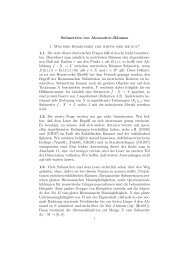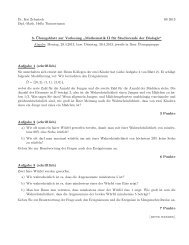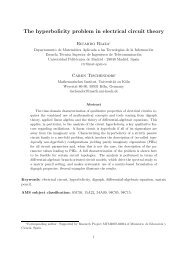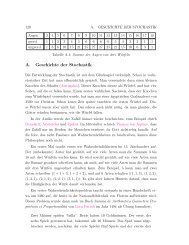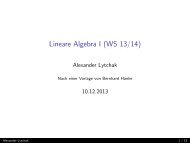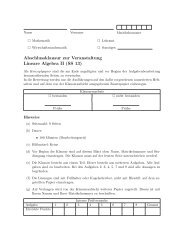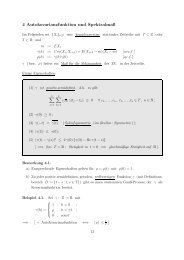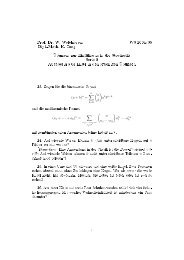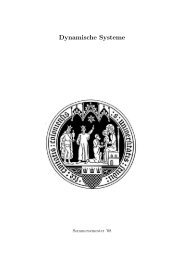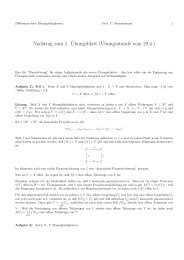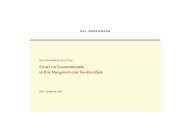Inhaltsverzeichnis - Mathematisches Institut der Universität zu Köln
Inhaltsverzeichnis - Mathematisches Institut der Universität zu Köln
Inhaltsverzeichnis - Mathematisches Institut der Universität zu Köln
You also want an ePaper? Increase the reach of your titles
YUMPU automatically turns print PDFs into web optimized ePapers that Google loves.
DMV Tagung 2011 - <strong>Köln</strong>, 19. - 22. September<br />
Michael Baake<br />
<strong>Universität</strong> Bielefeld<br />
Kinematic diffraction from a mathematical viewpoint<br />
Mathematical diffraction theory is concerned with the analysis of the diffraction image of a given structure<br />
and the corresponding inverse problem of structure determination. In recent years, the un<strong>der</strong>standing of<br />
systems with continuous and mixed spectra has improved consi<strong>der</strong>ably, while their relevance has grown<br />
in practice as well. Here, the phenomenon of homometry shows various unexpected new facets, particularly<br />
so in the presence of disor<strong>der</strong>. After an introduction to the mathematical tools, we review pure<br />
point spectra, based on the Poisson summation formula for lattice Dirac combs, aiming at the diffraction<br />
formulas of perfect crystals and quasicrystals. We continue by consi<strong>der</strong>ing classic deterministic examples<br />
with singular or absolutely continuous diffraction spectra, and we recall an isospectral family of structures<br />
with continuously varying entropy. We close with a summary of more recent results on the diffraction of<br />
dynamical systems of algebraic or stochastic origin.<br />
Literatur<br />
Baake, M. and Grimm, U. (2011). Kinematic diffraction from a mathematical viewpoint, Z. Krist. 226, in<br />
press; arXiv:1105.0095.<br />
Baake, M., Birkner, M. and Moody, R.V. (2010). Diffraction of stochastic point sets: Explicitly computable<br />
examples, Commun. Math. Phys. 293, 611–660; arXiv:0803.1266.<br />
Volker Bach<br />
<strong>Institut</strong> für Analysis und Algebra, Technische <strong>Universität</strong> Braunschweig<br />
Existence and construction of resonances in minimally coupled nonrelativistic QED<br />
An excited eigenvalue of an atom is believed to be unstable and turn into a resonance un<strong>der</strong> a perturbation.<br />
In this talk the precise definition of such resonances is given and their existence and construction<br />
is outlined in case the atom is minimally coupled to the quantized radiation field. This model is infrared<br />
singular and notoriously difficult to treat. We review Sigal’s recent construction of resonances based on<br />
the “Feshbach map" and present a novel, alternative construction based on “Pizzo’s method".<br />
Dorothea Bahns<br />
<strong>Universität</strong> Göttingen<br />
String theory outside the critical dimension<br />
I will review some recent developments in string theory in a setting initiated by Klaus Pohlmeyer in the<br />
1980s. Here, a Poisson algebra is assigned to surfaces of extremal area immersed in Minkowski space,<br />
e.g. to the world sheet of a string. Two deformations of this Poisson algebra (quantization schemes) have<br />
been proposed. One is based on the quantization of an auxiliary Lie algebra in terms of its universal<br />
enveloping algebra, the other is based on the deformation theory of quasi-Lie-bialgebras. Contrary to<br />
the ordinary setting of string theory, which is based on conformal field theory, these two quantization<br />
schemes do not require a critical dimension for consistency.<br />
73




